
Naturally, I bought it.
I scanned the beautiful Chesley Bonestell cover, an unrelated but gorgeous piece of art. I scanned the interior art for "The Fireman" as well. All now are posted to the "Other SF Art -- Pulp Magazines" page of my web.
And then I read the Bradbury.
How does it compare with the fuller Fahrenheit 451? Well, "The Fireman" is much smaller and faster, not nearly as polished, and the reader is always thinking, "Oh, but where's--?" or "Is he gonna say--?" The piece is a fascinating historical artifact, but quite a rough draft for those of us used to the novel.
Montag's first name is Leonard--no Guy Fawkes-ism yet. Faber has a first name, too. Beatty is Leahy. Yet despite the 2052 date in the first page, unlike in the novel, the setting is more reminiscent of the time of writing, with no full-wall televisions yet, just actual TV sets and radios and even crap-magazines. There's no green bullet from Faber, so we just plain old don't see him again until after the showdown. Interestingly, Beatty's lecture over Montag's sickbed is just a teeny bit more specific on the "minority pressure" aspect than in the novel.
Once Montag reveals the books to Millie, he gets her--amazingly, to our minds now--to agree to daily readings, with him trying to teach her. Montag actually is a tad bloodthirsty in a couple of places where thinking about the revolution, less diffident than in the more slowly unfolding novel. And the Hound-- Why, the Mechanical Hound doesn't appear until almost the end! There are no creepy firehouse growlings, therefore, no offhand mention of suicide by Hound, no electronic snuffling under Montag's door. And it's called the Electric Dog, fer God's sake... Wow.
Still, the novella is definitely worth the read. And at least here you may enjoy the visual art as well!
Rafeeq




 RSS Feed
RSS Feed
